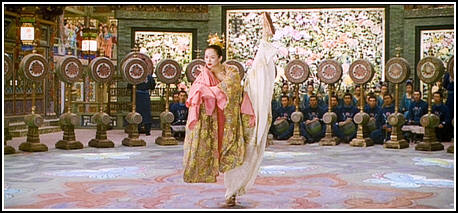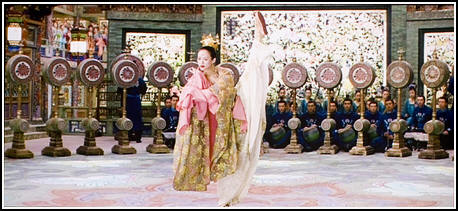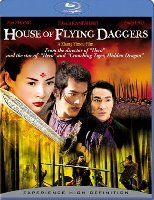Along with Blu-ray's first crack at The Fifth Element, their House of Flying Daggers had its reported share of problems. However my experience of Blu-ray and a number of other SD editions (the R1, Chinese R3 and the Japanese R2) is that all of them were an improvement over my theatrical experience of the movie. The print I saw in a new, first run theatre was marred by over-brightness and an insufferable, persistent, inappropriate grain. I found no good reason, considering the nature of the drama or the production design, for the existence of such a grain. It's not film noir, after all. These same qualities persist in my home theatre experience, regardless of edition, but not to the same degree as what I saw in the theatre. To blame Blu-ray for the result is, I feel, misplaced.
You might be able to find encoding missteps, but they pale to insignificance compared to the film's grain and inherent lack of sharpness for long stretches. I have watched some 14 Blu-ray movies from 1956 to 2006 and none, but the first hour of Superman suffer from such a lack of acuity. The worst case in Daggers is the two extended dance sequences at the Peony Pavilion. That distracting coat of snowy grain pervades the entire scene - at times worse than other, but never absent. When the camera is directed to the gallery, we are greeted with a sea of indeterminate faces; the floor has a pattern, but is made of no particular material; the drums have no tension in the skins and the design on them indistinct; Mei's face has no sense of flesh, just powder. At other times in the movie, the image is quite satisfactory: When Jin dresses Mei after the first attack in the forest, we can feel the quality of the fabric of his coat that's as luxurious a textile as it stunning in color; and in the final close-ups between Jin and Mei, the picture as good as one could hope for.
The theatrical presentation affected us because of the color, the costumes, the bodaciousness of the drama, the amazing effects and set pieces. But if you saw a similar print to the one I did, you would have been unhappy. (The same was true for Zhang Yimou's Curse of the Golden Flower, by the way, but not for Hero – all seen at the same theatre on the same screen.) I comment on this for two reasons: one to excuse in part Blu-ray from the result, but also to point out what we all know, but sometimes forget at home: just how awful prints and projection can be in the theatre. When was the last time you noticed a focusing problem with your DVD?
The Score Card
The Movie : 7.5
In Japan the English title for the movie is "Lovers" – not as catchy, perhaps, but somehow it makes the ending and the bizarre dynamics between Mei, Jin and Leo at the Peony Pavilion more interesting on second viewing. I assume that by now you enough about the movie that my telling you that Zhang lies to his audience in the biggest possible way for the first 3/4 of the movie and that, especially on second viewing, we are likely to be righteously pissed, since there are no clues to the lie. You'd have better luck trying to prove that Ridley Scott drops clues to Deckard's being an android (a take I happen to abhor, by the way). The lie is an essential part of the drama, as it is a necessary ploy to trap those that oppose the revolutionary group we are set up to empathize with. But even when there is no one around to deceive, Zhang persists in maintaining the illusion. It's as effective a piece of drama as it is abusive to the audience. So, one's appreciation of the film must lie elsewhere.
The triangle between Mei, Jin and Leo is first exposed at the Pavilion -
part of the reason why I fancy the Japanese title. Mei may be blind, but
Jin is blind drunk, and Leo, consumed with the power of knowledge. In
later scenes the dazzling primary and secondary colors of the Pavilion
are broken down into tableaux, each with their own color scheme – a
favorite device of Zhang's, culminating in white, which is either all
the colors or none at all, life forever or drained of all life,
depending on your point of view. The set pieces in the forest and on the
plain are dazzling exercises of choreography, making use of special
effects for the highest purpose. And while flying daggers and weapons of
all sorts are manifest, it is still the love story that is center stage.
The end is inevitable, given the forces at work – dramatic, moral,
artistic and technical.
A triangulated love story, where fatalism and deception plays as
important a role as stunning set pieces, color and costume design. I
like House of Flying Daggers better each time I see it. Yet I find that
the love scenes, such as they are, are weak. I remain unconvinced in the
clinches, though the affect is sincere enough. Takeshi Kaneshiro and
Andy Lau, I felt, were more convincing in this area than Zhang Ziyi.
Zhang, unfortunately spends most of the movie lying to the audience,
which makes it hard to identify with her rolling emotional states. Lau
lies, too, but he gradually lets on to us in each successive scene where
he warns Kaneshiro about the business at hand. Kaneshiro does most of
the emotional work in the film. He is the only character whose mission
and internal conflicts are clear to us from the start. When he aches, we
ache. When he commits, we sigh and grieve. House of Flying Daggers is a
film not without substance, for all its effects: Like the theme of Les
enfants du paradis, men would rather hang onto their dreams of what
should be than what can be, or what is.
Image : 5.0~7.0
The aspect ratio measures about 1:2.35, as it should, but the cropping
is off. While this is not an issue for most of the film, there is one
moment at least where the error cannot be ignored: As Mei prepares for
the "bean dance" she opens her body from floor to ceiling in a
jaw-dropping, impossible extension. The camera frames her tightly, but
the Blu-ray cuts off her foot at the ankle, hardly what could have been
intended. The Edko crops the horizontal and the foot; the R2 manages to
keep Mei's foot in the frame but crops a considerable amount from left
and right.
Blu-ray

Japan (R2)

Edko (R3)

Curiously, the Edko release has a similar color palette and contrast to
the Blu-ray, but the Japanese SD is very different in respect to both
brightness and cropping: The brightness level is much lower, making the
color more saturated, though the blacks tend to block up a little. The
big scene on the open field suffers. The tall grass should seem paper
thin, but alive, as Jin rides through it and gathers flowers from his
horse.
Emotional Connection : 8
I am guessing that the blame lies with the original film/digital
processing –a quite different affair than Zhang's
Hero (or from
Curse of the Golden Flower for that matter.) That said, I was able to accept this
BD image for long stretches, taken out of the movie only now and then by
its missteps.
Operations : 7
One thing I like about Blu-ray, as compared with SD is that the movie
remains operational while sorting out a change in the menu – a
picture-in-picture function, as it were. I found that that there were
too few scenes, though all of them fit neatly in a single row across the
frame.
The subtitles are in a yellow font, at times extending up into the image
where they are outlined in black, and partly below the frame – Why not,
I ask, entirely below the frame, while they're at it? But here's a
treat, the sub's are not bitmapped. No jagged edges. Just as clean as
you could want. While colored sub's are always a no-no for black & white
films, here, where color is the order of the day, they sort of fit. The
sub's for
Kung-Fu Hustle, by the way, are in white font, which I find
them distracting for that film. Perhaps it's just they are too bright
for the movie.
Loading proceeded briskly, with no extra time required to wade through
endless previews or warnings.
Extras : 3
There are only two: a storyboard-to-film demo for a couple of sequences.
I'm always impressed that someone drew all these scenes, including a
feel for the composition as if seen from the point of view of the
camera. The final realization is a magical transformation. The other
special feature consists of some very brief visual explanations of how
beans, arrows or daggers were shot using CGI – all in academy ratio by
the way, with would have been an image score of 1 or 2. I weep.
Leonard Norwitz
LensViews
June 3, 2007
NEXT WEEK:
The Road Warrior &
Superman: The Movie
COMING SOON:
Pirates of the Caribbean: Curse of the Black Pearl
Pirates of the Caribbean: Dead Man's Chest
Curse of the Golden Flower
Good Night, and Good Luck
The Searchers
The Queen
Unforgiven
Casino Royale
Enter the Dragon
Kung-Fu Hustle
Rocky
Reds
